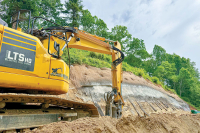Compromise forged to save metal truss bridge
 Macon County residents hoping to save an old metal truss bridge spanning the Little Tennessee River scored a small win, but the victory is bittersweet.
Macon County residents hoping to save an old metal truss bridge spanning the Little Tennessee River scored a small win, but the victory is bittersweet.
The one-lane McCoy Bridge that has become a rallying cry for one mountain community’s rural character will be spared the wrecking ball but will be demoted to foot and bike traffic only. A bigger, wider bridge will be built over the river for vehicle traffic.
County commissioners last week officially signed onto the compromise that has been percolating between the county and the N.C. Department of Transportation for more than a year.
In a saga that has lasted more than a decade, a group of local residents pushed to keep the bridge. The bridge was deemed “functionally obsolete” by the N.C. DOT, which originally proposed to tear it down and replace it.
After years of community meetings, public comment, a myriad of studies, and back and forth between residents and the DOT, a compromise was born that keeps the bridge in place to serve pedestrians and cyclists, while constructing a new bridge further downstream.
The deal hinged on support of the Macon County commissioners, however. The DOT wanted to divest itself of long-term liability and upkeep on the old truss bridge — which meant someone else, namely Macon County, would have to take it on.
Related Items
Commissioners last week voted 4 to 1 to assume responsibility for the bridge in the long-term. Under the agreement, the DOT will maintain the metal bridge for eight years after the new one is completed — paying for required bridge inspections every two years and alterations to close it off to vehicles — before handing it over to the county.
At least two county commissioners were hesitant to enter into the contract with the DOT, however. County Commissioner Paul Higdon voted against the agreement because he was afraid of mounting repair and maintenance costs for the “deteriorating” bridge once the county took it over.
And, as a stipulation of the agreement, if the county doesn’t keep current with its upkeep, DOT will dismantle the bridge at a cost of $126,000 and bill it to the county.
Commissioner Ron Haven was also hesitant to go along with the plan, citing unknown costs, but relented at the final vote because of what the bridge meant to the community.
Doug Woodward, a retired engineer who has helped lead the community’s charge to keep the bridge, said the compromise wasn’t what he had been hoping for. He wanted to see the metal bridge remain as the primary bridge for traffic.
“The new bridge would serve very little purpose,” said Woodward. “It essentially goes nowhere.”
Those living on the other side of the Little Tennessee River from N.C. 28 have only a few options to get across. For those that rely on the McCoy bridge as the nearest, most convenient crossing, the next closest bridge is a few miles — about 10 minutes on rural roads — in either direction.
Those two bridges handle the majority of traffic to communities on the rural enclaves on the other side of the Little Tennessee, while the McCoy bridge is used only by a comparative handful of local traffic.
Woodward said the bridge is one of only 30 or so metal bridges left in the state, and he would rather see it restored and widened rather than a new vehicle bridge built that could cost millions of dollars.
He said new bridge construction could disturb nearby archeological sites and harm the river’s habitat. Furthermore, he believes it isn’t necessary.
“When you get a very large organization, it tends to need to generate jobs to keep itself going,” Woodward said of the DOT. “Bridges are one way they can justify more work.”
But for Brian Burch, a construction engineer with DOT, the old bridge just isn’t safe enough to sustain heavy loads anymore. The DOT has classified the structure as a fracture critical bridge with a maximum load weight of three tons — just above the weight of standard car and well below that of larger vehicles such fire trucks and school buses.
Also, the old construction style of the bridge means there is no fail-safe if certain parts of the structure break.
“It doesn’t meet current standards,” Burch said. “It’s a single-lane bridge; also, it has certain structural members where if they fail the bridge would not be safe.”
Burch said the bridge was built in 1960 and is not on the state’s historic structures list, but some residents contend it is far older and does have historic significance.
DOT originally wanted to tear it down, because as Burch put it, “If there’s another bridge that is adequate, why keep the metal bridge?”
But amidst the public outcry, the department agreed to a deal with commissioners in which the agency will pay for the bridge inspections, at about $8,000 a pop every two years, for nearly a decade.
But that clock doesn’t start ticking until after the new one is constructed. Burch estimates completion could be as far ahead as 2018. In the meantime, vehicles will continue to use the steel truss bridge.
County Manager Jack Horton believed that if only used for foot and bicycle traffic, the bridge’s integrity will not be an issue, and it may even act as a draw for visitors. Horton said the county is looking at placing a parking area nearby so people will have easier access to use the bridge once it is off-limits to vehicles.
“Because it’s just going to be bicycle and foot traffic, I think it will last a long time,” Horton said. “This was the only way we had to keep the bridge and preserve it.”









